Your Brand: Built by Leaders, Confirmed by Customers
Jack Young
- Last Updated: 15 August 2025
Table of Contents
Key Takeaways - Your Brand Built by Leaders
- Leadership defines first: Brand identity and values must be set proactively by leadership, not left to customer perception.
- More than a business: Competing solely on product and price leads to commoditisation. A brand creates loyalty, margin, and emotional connection.
- AI is the new brand filter: AI favours clear, consistent, values-aligned brands. Without one, you vanish from the conversation.
- Trust as a risk reducer: Strong brands lower buying risk, build loyalty, and are harder for competitors to replicate.
- Brand stages: A strong brand goes through the 3C’s: Convincing, Confirming and Co-creating.
- Mission statements must breathe: Values must guide daily decisions, hiring, training, service, and leadership behaviour.
- Visuals support actions: Logos, colours, and taglines can only strengthen a brand if they’re backed by consistent action.
- Consistency across touchpoints: Every stage of the customer journey, from website to delivery and aftercare, must reflect the brand’s values.
- Packaging matters: It’s often the first hands-on brand moment. Good design turns delivery into a memorable unboxing.
- Adapt without losing your identity: Adapt within your core values, embrace a niche if the audience is smaller but loyal or create a separate brand for a different market.
TL;DR - Your Brand: Built by Leaders, Confirmed by Customers
A brand is not defined solely by what customers say. It begins with leadership intentionally setting values, purpose, and narrative. The brand is then proven by consistent customer experiences and strengthened through shared ownership between leaders, employees, and customers.
In furniture retail (and increasingly across all industries), AI and value-driven consumers are making it essential to have a clear, lived brand identity. Logos, colours, and marketing matter, but they mean nothing without tangible action that delivers on your pledges.
Adaptation to market changes is essential, but it must be done without losing brand integrity. That can mean refining offerings within your values, doubling down on your niche, or creating a separate brand for new market segments.
The lifecycle of a successful brand moves from Convincing to Confirming, then finally to Co-creating.
The strongest brands are built by leaders, confirmed by customers, and co-created by all.
The Branding Misconception
I’ve been seeing a lot of quotes and statements recently. The algorithms just keep feeding me more and more, to the point that I need a digital Rennie.
The one topic currently giving me the most indigestion is branding. Mostly, those quotes that say something along the lines of “Your brand is whatever the customer says it is.” Which have probably been taken from a quote on branding attributed to Jeff Bezos. “Your brand is what people say about you when you’re not in the room.”
The Bezos quote suggests that a brand is not just what a company says about itself, but rather the public perception and reputation it holds. Highlighting the importance of building a strong reputation. And I agree.
But while Bezos’s quote rightly highlights reputation, it can be misinterpreted. The reality is that reputation can’t be left to chance. It’s a direct result of the proactive choices a business makes.
Branding must start with the business, not with the customer. This may seem obvious, but it is often not the case.
This is not to say that a strong brand defined by leadership shouldn’t be open to customer feedback and willing to adapt if it’s not connecting with an intended audience. Adjusting your brand based on real insights is different from letting customers define your brand entirely. Leadership should be setting the direction and values first, then refining the story to better connect, often with the help of those who live and experience your brand every day—without ceding control.
You must guide the customer along a journey you’ve designed to help them discover their ideal solution.
What’s the difference between a business and a brand?
A business is an organisation that sells products or services to make money. It often relies on purely transactional customer relationships, where the interaction begins and ends with the purchase. This is an “experience” that can be easily replicated by competitors.
A brand is much more than that. It’s the identity and personality of your business, the pledge you make, the emotions you evoke, and the reputation you build over time. Your brand shapes how customers feel about you and why they choose you over others.
Why Being a Brand Matters
Before we get into branding, it’s important to address why being a brand and not just a business is essential.
Many retailers rely heavily on the reputation of supplier brands to reassure customers. It’s natural to use the “halo effect” of well-known product brands to reinforce your own business. However, it’s important to recognise that your business must develop a distinct brand identity that sets you apart from other retailers selling the same products.
Think of your business brand as an umbrella determining customer expectations and trust at every touchpoint, from browsing and sales to delivery and aftercare. While supplier product brands contribute value and are part of the story you tell, they do not replace the need for your own brand’s purpose, values, and personality.
This is especially true in the crowded furniture market, where many retailers stock identical or similar products. Your brand becomes the unique reason customers choose you, not just the product itself. It’s this owned brand identity that builds loyalty, justifies margin, and differentiates your business beyond price and product features.
Customers often buy identical products from larger retailers simply because those businesses represent something, whether that’s reliability, values, lifestyle, or trust. If your business doesn’t clearly stand for something different and meaningful, you risk losing customers to those “big boys,” even if you offer similar or better products.
Without building a deeper connection that gives customers a reason to choose you over the competition, you’re competing in the commodity trap, where price is the only differentiator, and that’s a battle that’s hard to win.
A brand is the solution to the commodity sickness.
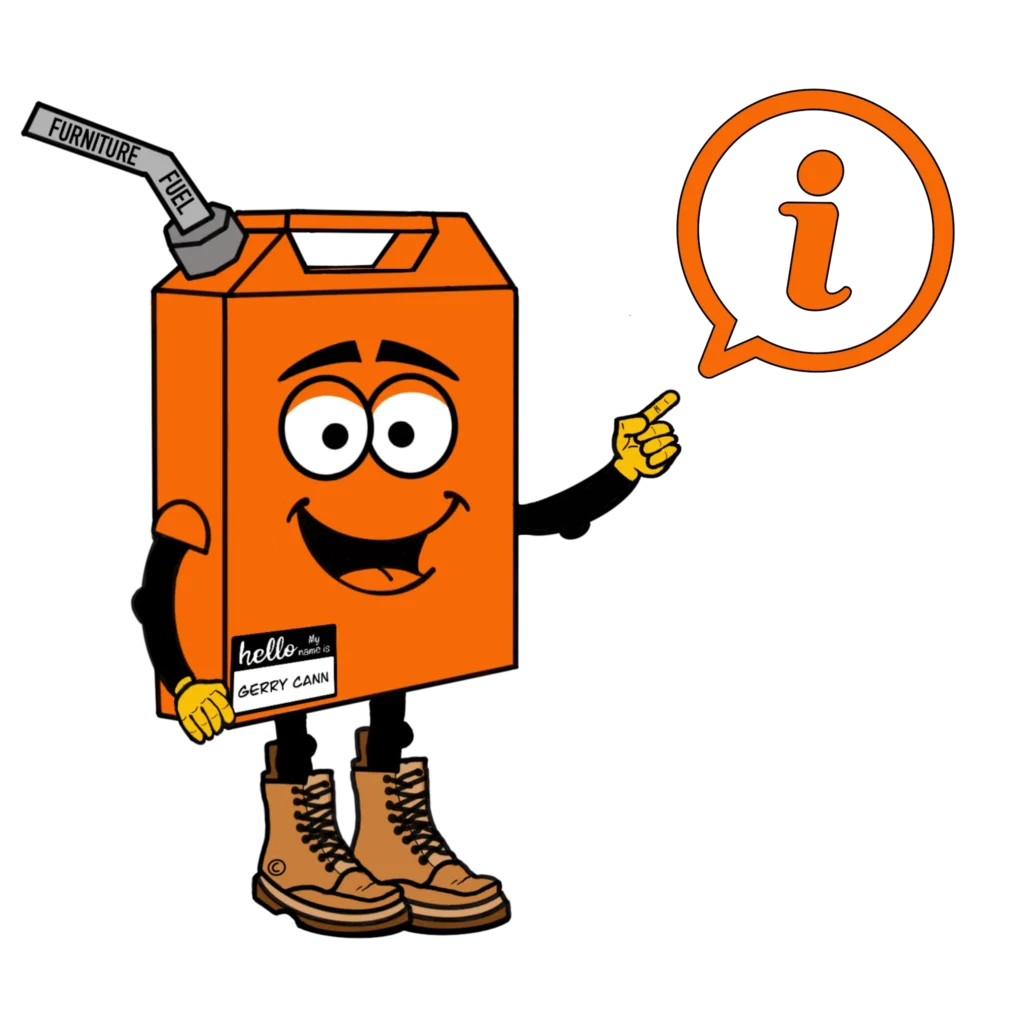
The halo effect is a cognitive bias where a positive impression in one area influences our feelings about everything else. In retail, it’s why a customer’s trust in a well-known brand—say, a famous mattress or upholstery maker—rubs off on the store selling it. This “borrowed” halo boosts confidence in the retailer’s quality, service, and expertise.
AI Is the Ultimate Brand Filter
In the past, customers typically researched a company’s about us page or scoured reviews “manually”. Now, AI-powered search engines and recommendation algorithms are becoming incredibly sophisticated at understanding not just what a user wants (e.g., an oak double bed) but who they are and what they value (e.g., ethically sourced, eco-friendly, family-run business, known for hassle-free delivery).
If your furniture brand hasn’t clearly planted its flag and lived its values, AI will struggle to make that value-based match for the customer.
Reinforcing the Person, Not Just the Product
Consumers, particularly younger generations, are making buying decisions based more and more on their personal values, identity, and lifestyle.
For furniture, this means an environmentally conscious buyer will actively look for brands that prove their sustainable practices, not just claim them.
The product becomes the manifestation of the brand’s values, which in turn reflect the consumer’s values. If that primary values-alignment isn’t there, the product might not even get a look-in.
Brands Act as a Risk Reducer
A strong brand is an earned risk reducer.
In furniture retail, a strong brand is a powerful asset because a sofa or dining table is more than a simple transaction—it’s a significant investment of a customer’s time, money, and trust.
Hard-won trust allows customers to make a purchase with confidence, transforming their buying decision from a gamble into a sound, predictable choice.
A strong brand then acts as the ultimate competitive advantage. It becomes a package deal, not readily replicable.
AI has made being a brand a non-negotiable requirement. What was once a “nice-to-have” is now fundamental for discoverability and connection. Rather than simply searching for product specifications, these advanced systems are programmed to find the most trustworthy and reliable options.
They don’t just match keywords. They analyse the tone, language, and substance of your brand’s communications and customer feedback. They form a working profile of your brand, an aggregated impression. This ‘AI sentiment’ then determines whether your brand is surfaced to customers whose priorities align.
AI actively seeks out brands that have proven themselves as risk reducers. If you don’t have a clear identity, AI can’t effectively put you in front of the right customers who are increasingly searching for brands that connect with them, not just generic products.
You become invisible in a sea of undifferentiated businesses, leaving you to compete solely on price.

AI sentiment is the overall impression or “feeling” an algorithm forms about your brand. Rather than just matching keywords, AI systems analyse the tone, language, and substance of your communications, from customer reviews and social media comments to your website copy. Think of it as a digital reputation score.
The Essence of Branding: Convincing to Confirming
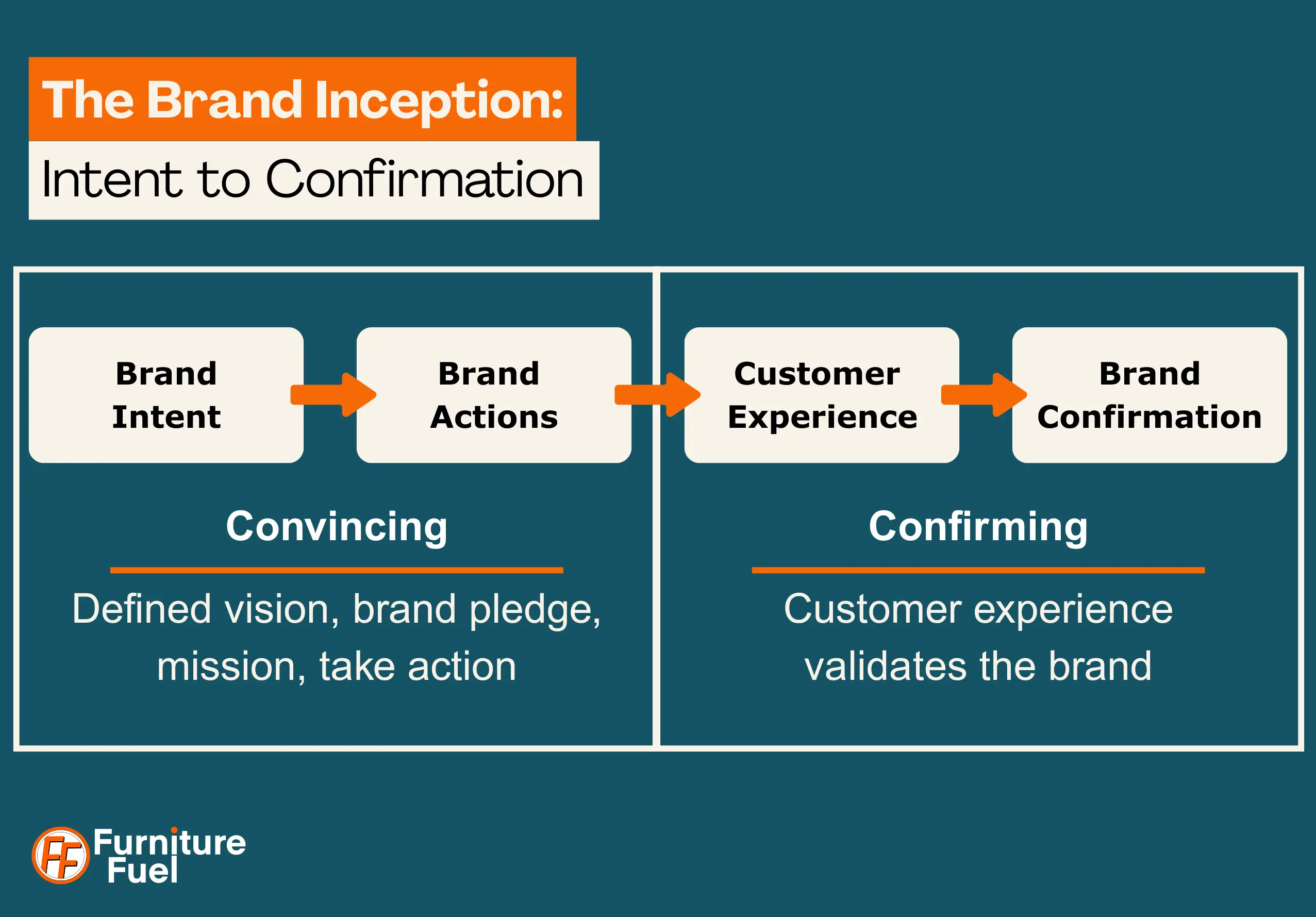
Stage 1: Convincing
It is up to the business to establish its initial brand. It must “plant a flag,” choose its values (e.g., quality, sustainability, affordability, design). What do does it sell, why and importantly, why does this benefit the customer?
It becomes the brand pledge. Buy from us, get the product needed, plus all this additional value.
This initial brand identification and story is about convincing customers. More than just a checklist of values or a mission statement, an effective brand is led by a compelling story. Leadership’s job is to define a narrative that gives meaning to the brand’s actions and choices. A narrative that customers can see themselves in.
People connect with stories, not just features or credentials.
For example, Patagonia’s reputation for environmental stewardship isn’t defined only by what customers say; it’s constantly reinforced by bold, visible decisions from company leadership—like their ‘Don’t Buy This Jacket’ campaign and commitment to environmental causes. A strong brand story, lived out in real choices, is what customers buy into and share.”
The shift comes, though, as you become established.
Stage 2: Confirming
In stage 2, the customer begins to confirm the brand.
Customers aren’t convinced by ads alone. They need their experience to confirm your pledges. So, your brand pledge then becomes more about “confirming, not convincing.” Every interaction is a moment of truth where your brand is confirmed or contradicted.
This includes:
- Pre-Purchase: Website navigation, showroom experience, sales consultations.
- Purchase & Delivery: Order accuracy, timely and professional delivery, and communication throughout.
- Post-Purchase Experience: Clear assembly instructions, accessible customer service for queries/issues, reliable warranty, seamless returns, and after-care advice.
The Amplifying Effect: User-Generated Content (UGC)
This is where User-Generated Content (UGC), such as reviews, photos, and social media posts, becomes so powerful. It is the ultimate method of confirmation, providing authentic social proof that proves your brand is consistently living up to its pledge because it comes from a trusted, usually unbiased source—other customers.
The Breathing Brand: Living Your Values Every Day
Mission & Values: More Than Just Statements
Too often, a company’s mission statement is a carefully crafted declaration that lives on the About Us page and hangs on the wall. Yet, these static, forgotten statements rarely have any impact on day-to-day operations. They are a relic of a strategy meeting that has long since been filed away, detached from the people who are meant to embody them and, in turn, detached from the customer experience.
Instead, a brand’s mission and values must be treated as a breathing document—alive not just in name, but in practice, constantly sustained through action.
A commitment to “customer satisfaction” isn’t just a pledge, it’s the standard that dictates how a delivery is scheduled, how a complaint is resolved, and how the sales team are trained. A mission statement should be a constant, living guide that keeps the entire business aligned with the brand’s core purpose, preventing the kind of internal and external disconnect that can destroy all your hard work.
Many furniture retailers rely heavily on generic brand pledges that are rarely backed up. They’ll say things like “made-to-last quality” or “we’re committed to our customers” on their About Us page. While these statements are a necessary part of the brand story, they are just words until they are confirmed by consistent action.
An example of a brand moving beyond words is Oak Furniture Land’s “new” Lifetime Furniture Guarantee. Their brand has always been, according to their about us page, built on a commitment to quality, and this new policy backs up that claim with a pledge to repair or replace the structural framework of their products.
By doing this, Oak Furniture Land moves its brand from simply saying they are “made-to-last” to actively proving it. Of course, the true test of this pledge will come in the experience of a customer needing to make a claim—and the effectiveness of any guarantee is ultimately defined by the transparency and ease of the customer service and repair process, which is the ultimate moment of truth for the brand.
Consistency Across All Touchpoints
The customer journey is long and a multi-layer experience. It often begins with the identification of a want or need. If they have found you through an ad, then it begins with your website or showroom, moves through the sales process, extends to the order fulfilment and delivery, and concludes with after-sales support.
If your brand pledges “effortless quality,” but a delivery team is unprofessional or a product arrives with a defect, that pledge starts to fray. Your values must be the unifying thread that connects every department, from the marketing to the warehouse team, to ensure a seamless and consistent brand experience.
Guiding Daily Decisions
A mission statement should serve as a moral compass for the business, empowering your teams to make decisions that are not just profitable but also brand-aligned. For example, if your core value is “handcrafted quality,” this must directly inform your sourcing strategy and supplier selection, guiding you away from cheaper, mass-produced alternatives. If “customer delight” is part of your core mission, it should inform the tone of your returns policy, enabling your customer service team to resolve issues with empathy and autonomy.
Cultivating Brand Culture
Internal alignment requires a proactive, consistent effort to embed your brand’s values into your company’s DNA.
- Onboarding: This is the first and most critical opportunity. New hires should not just be trained on product knowledge and processes but also in the brand’s mission. They must understand not just what they do, but why they do it. HR is a main driver in this effort, as they must seek candidates who already align with the brand’s mission. While skills can be taught, a shared sense of purpose is the foundation of a strong brand culture.
- Ongoing Training: Brand alignment is not a one-time exercise. Regular training sessions should be used to reinforce your values, providing real-world examples and tools for how to embody them in customer interactions, from ethical selling to effective problem-solving.
- Recognition & Rewards: What you incentivise, you get. Publicly recognising and rewarding employees who demonstrate your core values reinforces their importance and encourages others to follow suit. This shows the entire company that living the brand is valued and celebrated.
- Leadership by Example: Ultimately, a brand’s culture flows from the top. If management cuts corners on a pledge, no employee will take the mission statement seriously. A leader’s actions are the most powerful form of brand reinforcement.
The Hierarchy of Brand Elements
If we go back to Jeff Bezos’s quote on branding. “Your brand is what people say about you when you’re not in the room”. This boils down to one thing: an opinion is formed by action or inaction. Therefore, a brand is built upon the actions it takes and doesn’t take.
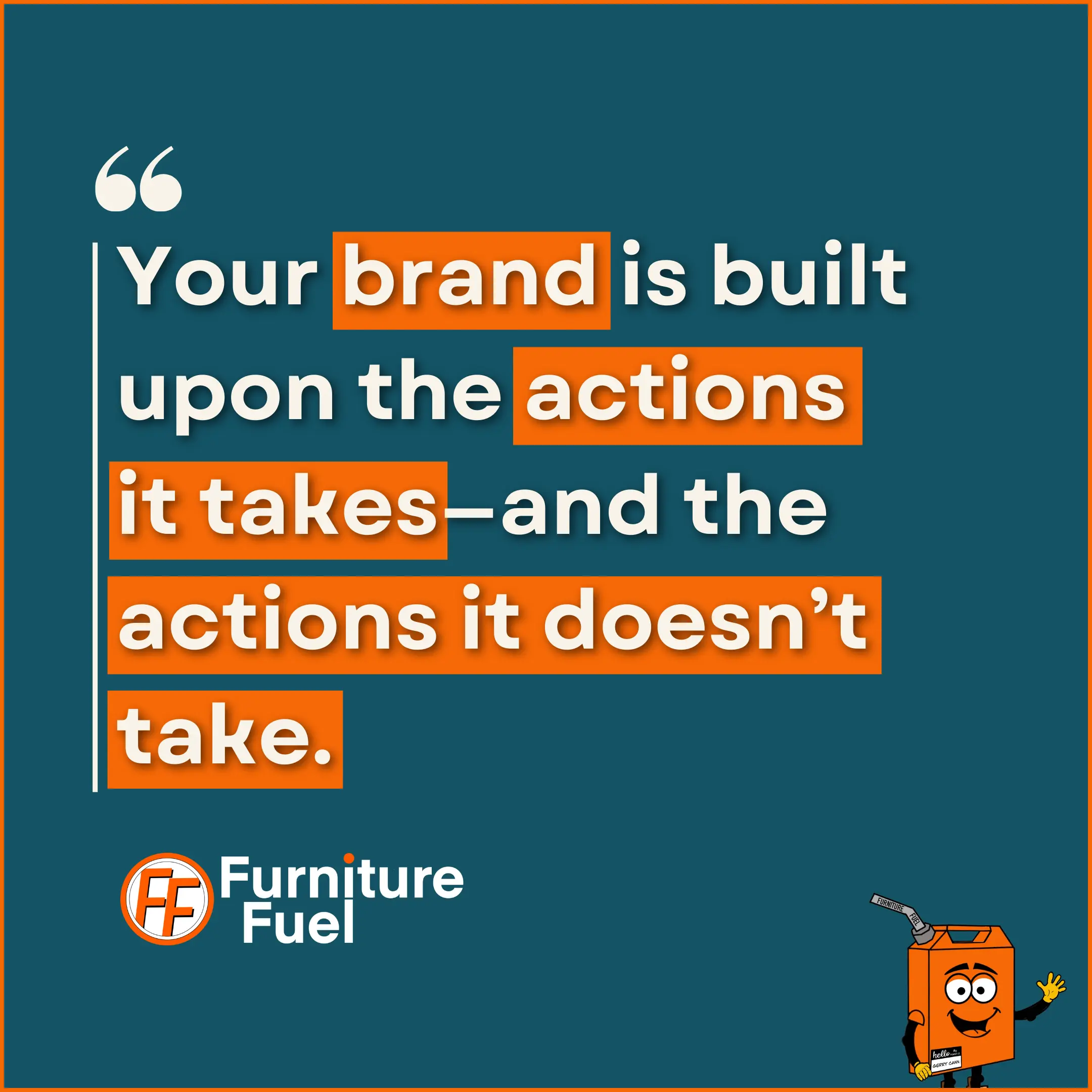
The Foundation: Doing What You Say
Let’s be clear about the hierarchy of what makes a strong brand. At the very foundation sits your actions, the consistent devotion to the pledges you make. Everything else, from your well-designed logo, with its hidden meaning, to your carefully chosen colour palette, is built on top of this.
This is not to say that there isn’t psychology in colour usage and that you shouldn’t have these well-designed, memorable brand elements. But if your product quality is poor, your delivery is unreliable, or your customer service is unhelpful, no engaging, viral, well-thought-out marketing matters.
Consistent action is the foundation of brand strength and trust.
The Reinforcers: Name, Logo, Colours, etc.
Think of your brand name, logo, and colours as the banners you fly. They can be powerful symbols, but they are only given true meaning by what you do. If your brand’s pledge is “uncompromising quality,” and a customer buys a beautifully designed sofa from you that breaks within a year, your logo becomes a symbol of disappointment if not resolved. But if that sofa exceeds their expectations and the service is flawless, that same logo becomes a symbol of trust and reliability. Your brand’s visual identity becomes shorthand for the positive experience you consistently provide—or for the negative one.
Consistent action is the foundation, but a brand’s visual, verbal, and experiential elements are the specific tools that communicate that authenticity to the world. When a brand’s actions are authentic, these elements work in harmony to tell a compelling story.
Visual Elements
These are the things customers see that are designed to be instantly recognisable.
- Logo: The primary symbol or emblem of your brand.
- Colour Palette: The specific set of colours used in all brand communications, which evoke certain feelings (e.g., earthy tones for a sustainable furniture brand, bold colours for a modern, edgy one).
- Typography: The specific fonts used for your brand name, headlines, and body text, which contribute to the brand’s personality (e.g., elegant fonts for a luxury brand, simple, sans-serif fonts for a minimalist one).
- Imagery & Photography Style: The specific aesthetic of your visual content. For a furniture retailer, this includes the lighting, staging, and composition of product photos.
- Packaging: Often the first hands-on brand moment, where design turns delivery into a memorable unboxing experience.
Verbal & Written Elements
These are the things customers read or hear that communicate the brand’s personality and pledge.
- Brand Name: The name of your brand.
- Tagline: A short, memorable phrase that captures the brand’s essence or value proposition (e.g., “Your home, beautifully simple,” or “Crafted for a lifetime”).
- Tone of Voice: The consistent style of language used in all communications, from website copy to social media posts and customer service emails (e.g., friendly and approachable, knowledgeable and authoritative, or witty and playful).
- Mission & Values Statement: The “breathing document” that defines your purpose and core beliefs, which we discussed, is a foundation of brand inception.
- Messaging: The key points, stories, and ideas that your brand communicates consistently to customers.
Experiential Elements
These are the less tangible but equally crucial elements that define how customers feel about your brand.
- Customer Service: The quality, friendliness, and efficiency of your interactions with customers, which directly confirm your brand’s values.
- Product Quality: The material, durability, and craftsmanship of your furniture, which is the most fundamental proof of your brand’s pledge.
- Delivery & Logistics: The reliability, professionalism, and ease of the entire fulfilment and delivery process.
- In-Store Experience: The atmosphere, layout, and sensory details of a physical showroom (e.g., lighting, music, scents).
- Website & User Experience (UX): The ease of navigation, clarity of information, and overall journey a customer has on your digital platforms.

Adapt to Thrive: Navigating Market Shifts with Brand Integrity
The furniture market isn’t static. Customer needs are constantly evolving, new trends emerge, and the world moves on.
A business that fails to adapt is on a path to extinction. Staying relevant requires the willingness to regularly re-evaluate your products, marketing, and processes to meet your customers’ changing needs and expectations. This is a fundamental part of survival.
The Brand Core Identity Dilemma
However, there’s a difference between adapting and completely changing who you are. Adapting might mean introducing a new furniture collection to reflect a trend towards sustainable materials, which still aligns with your core value of “thoughtful design.” A fundamental identity shift, on the other hand, would be if you’re known for high-end, bespoke cabinetry and you suddenly pivot to selling low-cost, flat-pack kits. Trying to make that kind of drastic change under the same brand name leads to a crisis of identity. It confuses your existing customers and makes your new proposition seem inauthentic.
Strategic Choices for Brand Survival
When faced with a market shift that challenges your core identity, you have two strategic choices, and both are about protecting the integrity of your brand.
- Option 1: Embrace the Niche: If your original market is shrinking but remains viable, you might decide to double down on it. You can accept that your audience is smaller but highly dedicated and valuable. Instead of compromising your brand to chase a new market, you become a focused, premium specialist for that niche.
- Option 2: Create a New Entity (New Brand): If the new market opportunity is too big to ignore and is fundamentally different from your core identity, the best decision is often to create a separate brand. This allows the new brand to build its own distinct identity from scratch, with its own mission and values, without diluting or damaging the trust you’ve worked so hard to build with your original brand.
Shared Ownership: Co-creating Brand Integrity — Stage 3
A brand’s credibility is not safeguarded by leadership alone. While strong leadership sets the initial direction and core values, ongoing brand relevance and strength require shared ownership across the organisation and its community. Strategic choices about adapting to market shifts must be enhanced by continuous input from customers and employees.
The most resilient brands don’t just adapt to trends—they co-adapt. This means listening actively to customer feedback, involving employees in living the brand mission daily, and making iterative improvements based on real-world insights. When customers and employees feel heard and valued as co-authors of the brand experience, the brand’s authenticity and trust grow stronger.
This may sound like a contradiction to the leadership defined, convincing, to the customer confirming stages—but it’s not.
Co-creation happens when satisfied customers and engaged employees become brand champions, telling your story in their own words, sharing lived experiences, and adding emotional credibility you can’t buy. This “social proof” amplifies your reach and contributes to building the brand’s legend.
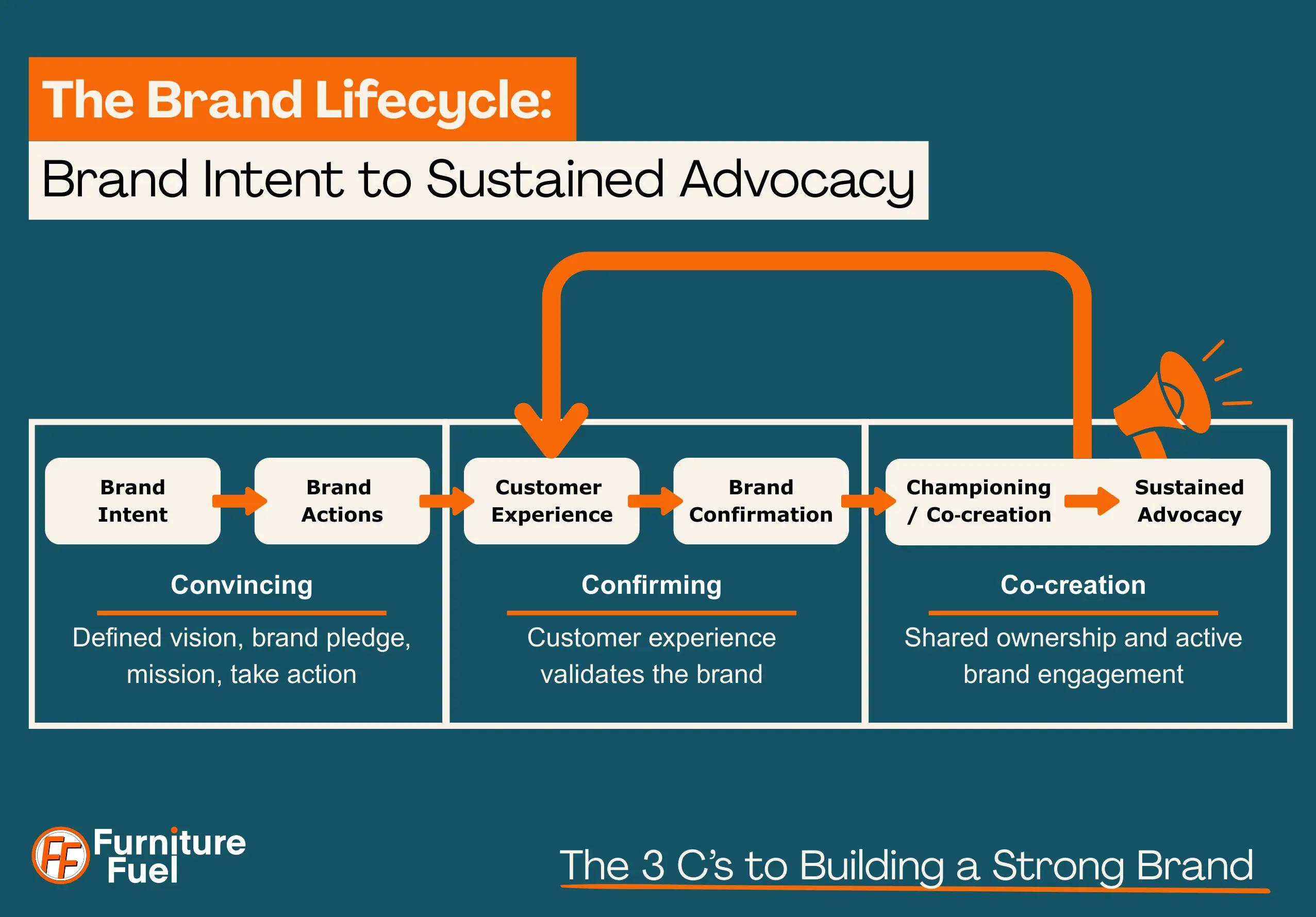
As long as the brand consistently keeps its pledge, champions will continue to promote it. Break the pledge, and you lose both your brand credibility and your hard-earned advocacy, breaking the loop.
The strongest brands are not dictated solely from the top but co-created by all who engage with them. Adaptation succeeds when leaders listen, employees embrace the mission, and customers feel genuinely part of the brand.
Built by Leaders. Confirmed by Customers. Co-created by All.
In a crowded market where countless businesses sell furniture, the challenge is to rise above the transactional and build something that truly connects.
The truth is simple: for you to have a brand in the first place, you must plant your flag and live your pledges. If you don’t have a brand, you have a business. And people want brands.
The brand you build is not a logo, a colour palette, or a marketing campaign. It is the sum of every customer’s experience on the journey. It is the trust you earn, the pledges you keep, and the gaps you proactively fill in.
But the strongest brands aren’t only confirmed by customers—they’re built with them. Long-term loyalty and resilience happen when employees and customers feel like co-creators, helping adapt the brand to changing needs without breaking its core promise. In that partnership, customers don’t just buy—they believe, advocate, and protect the brand as if it were their own.
A Call to Action for Furniture Retailers
Now is the time to assess your brand through this new lens. Look beyond your sales figures and ask the hard questions: Is our mission statement truly a breathing document? Are we consistently living our values in every interaction? Are the brand pledges we make being consistently confirmed by our customers’ experiences, and are we inviting those customers to help shape what comes next?
Long-term success, resilient customer loyalty, and future discoverability in an AI-driven market are no longer built on clever campaigns. They are built on authentic delivery of pledges, grounded in trust and shaped by shared ownership. The only way forward is to stop simply selling a product and start building a brand that customers want to champion alongside you.


